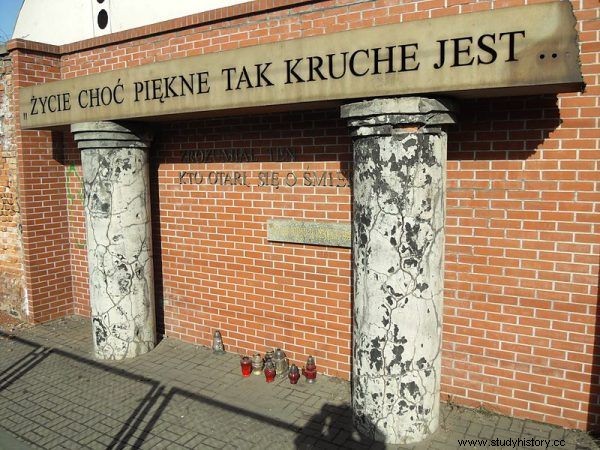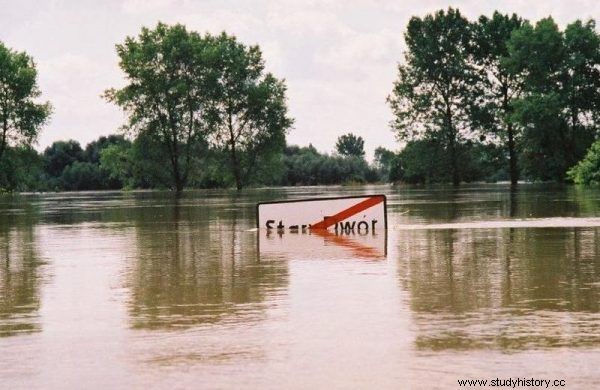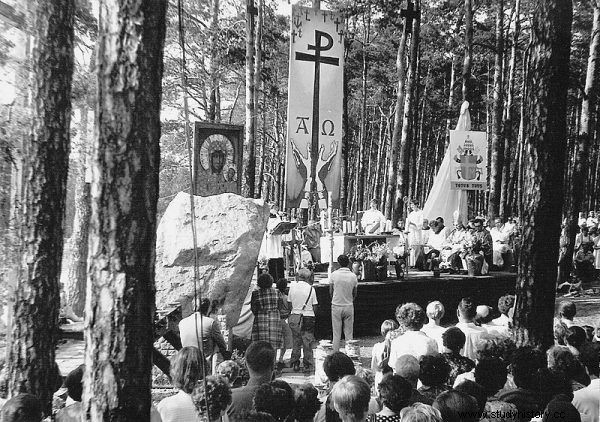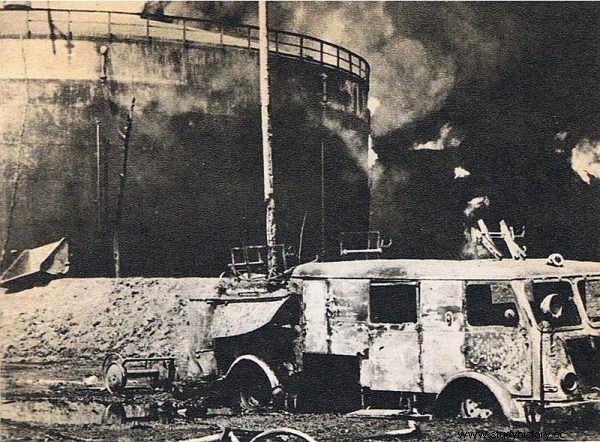Every day they selflessly risk their health and life to save others. Polish firefighters have often faced unimaginable catastrophes, fighting the elements and providing first aid to the injured. These are their most daring actions in the last half century.
The work of a firefighter is not only about extinguishing the fire - but also a long-term effort in which peace, courage and above-average mental resilience are no less important than the condition and strength. There is no room for fear or doubt. The stake in this "game" is human life, and the fight for it takes place in critical conditions:deadly heat, water, or collapsing buildings.
Over the last half-century, Polish firefighters have testified to their heroism more than once, including trying to curb the biggest fire in post-war European history which broke out on August 26, 1992 in Kuźnia Raciborska. Below are five more amazing actions they took part in.
1. There was nowhere to run
Nothing foreshadowed the tragedy. November 24, 1994 was to be a joyful date in the history of Gdańsk. On this day, a concert of the band Golden Life was planned, whose hit "Everything I have" attracted the audience from all over the area. The room was packed to the brim. At the fire station - medium GBA 2.5 / 16 fire truck and five firefighters.
As it was later established, the flames started around 8:55 pm . Under the stands there were warehouses filled with gymnastic mattresses, benches, boards, tables and tarpaulins. It was there that an unknown arsonist started the fire. Initially, little attention was paid to the fire. It wasn't until the lights went out that the audience panicked.

After a tragic fire, the band Golden Life recorded the song "24.11.94". A fragment of his refrain was placed on the monument that stood in front of the place where the unfortunate hall once stood.
The hall of the Gdańsk Shipyard immediately turned into hell. Worse still, most of the emergency exits are padlocked ! The open main door opened onto a tight sidewalk. There was a blockage, several people fell, people started trampling on each other. “Someone starts screaming that his hair is on fire, someone else is crying because the fire is jumping on his hands. And then it is too late for anything ”- they report in the book“ Firefighters. Where heroism begins ”journalists Joanna and Rafał Pasztelański.
It was only around 9 p.m. that the terrified crowd was released. A fragment of the fence at the exit was removed - and this most likely saved dozens of lives. The situation inside the hall was dramatic. As the operational officer of the State Fire Service in Gdańsk wrote in a memo:" People lie in layers in this place [at the fence separating the pavement from the track - editor's note aut.], the fire has already spread to the roof, I am starting the evacuation. ”
It was impossible to enter inside, the air temperature probably reached about 1000 degrees. The steel structure under the influence of fire began to deform. It was difficult to count the injured. Lighter burned on their own, they reached the hospital. Ambulances transported those in the worst condition. There weren't enough resources to help everyone.
It is estimated that there were about 2,000 young people in the hall when the fire broke out. A 13-year-old girl trampled by the escapees and a reporter from Sky Orunia, who returned to the burning building for equipment, died on the spot. Another 5 people died in the hospital. No wonder that this day went down in the history of Gdańsk as "Black Thursday".
2. The flood of the millennium
The Great Flood of 1997 claimed 114 lives. Seven thousand Poles lost their homes over their heads, and over 40 thousand Poles were deprived of all their belongings. And it all started so innocently on July 6. The inhabitants of the Opole region did not yet believe in the meteorological warnings repeated by the media . Meanwhile, the fire brigade was getting ready to fight.
The main headquarters located in Głuchołazy prepared a plan:to evacuate the population, defend embankments and bridges, and then - to provide water, food and medicines. After just a few hours, the surrounding towns began to look as if they had been prepared for the war! Protective dykes were laid in the streets and people were rushed to safe places.
When the tide came, many firefighters from Opole and the surrounding area were working while trying to survive on their own. “ At this point, you don't know how to pack. Whether for two days or two weeks. I threw underwear and socks into the bag, one by one, ”he recalled in the book“ Firefighters. Where heroism begins ”Adam Janiuk, who took part in the action from the very beginning. While he was wading in the water for days, his wife was administering tetanus medications to other firefighters at the clinic.
Each exit was associated with a high risk - the water was rushing, it created vortices. Boats were thrown in all directions. Many exhausted firefighters went to medical facilities where they were given drips with glucose and electrolytes. Their sacrifice was not appreciated. People rebelled, did not want to leave their apartments - they were afraid for their possessions. A bolt in a flood dyke was stolen, someone closed the dyke on purpose to redirect the water elsewhere. Firefighters had to fight not only with the elements, but also ... with human stupidity.

During the flood of the millennium in 1997, dozens of towns and villages fell under water. Thousands of Poles were deprived of the achievements of their entire lives by the force.
The water was falling until 30 July. The current carried with it fragments of buildings, trees, and washes away entire sections of roads. There were also more drastic views - a flowing corpse, as well as coffins washed out of the graves were eternally imprinted in the memory of the rescuers . There was a reason why the events of 1997 were called "the flood of the millennium."
3. Missing wagon
On August 19, 1980 at 4:18 a.m., the passenger train number 5130 to Łódź left the Toruń Główny station. Two minutes later, a freight train number 11599 left Otłoczyna towards Toruń. The driver of the freight train, Mieczysław Roschek, should not come to work that day . The exhausted man set off on the route despite the lack of permission, without waiting for an instruction. Then he chose the wrong track on the switch. One wrong decision led to a tragedy.
In 1980, the drivers did not have a radio station. Despite the fact that the railway traffic officers were aware of the danger, they could not notify anyone. At 4:30 a.m. the locomotives collided head-on:the passenger train was traveling at a speed of 85 kilometers per hour and the speedometer of the freight train showed about 33 kilometers per hour.
Passers-by were the first to arrive - although there weren't too many of them at this time. Fortunately, being aware of the threat, the dispatchers notified the Civic Militia in advance, which in turn sent fire brigades from nearby towns to the accident :Toruń, Aleksandrów Kujawski and Włocławek. The sight of the firefighters was gruesome:people trapped in the crushed carriages begged for help, but it was impossible to get to them. Spilled fuel stains were everywhere, making it impossible to work with hacksaws. Firefighters had to dismantle the wagons with… crowbars.

A monument dedicated to the memory of the victims was erected at the site of the crash near Otłoczyn. Pictured:Mass at the monument on the 4th anniversary of the accident.
Only after some time someone noticed that ... one of the carriages is missing. The passenger train had initially seven, but now there were only six on the tracks. Only after counting the load-carrying carriages it turned out that the first car was completely compressed. The corpse brought out of it no longer looked like humans .
“There are already over thirty bodies on the summit by the forest by eight o'clock. Nobody believes that the number of victims of the tragedy could increase. But after a while, militiamen and soldiers bring another body, some of them mutilated to such an extent that even the toughest men cannot stand the sight ”- reported Zbigniew Juchniewicz, the reporter of Toruń's News, who was present on the spot. The balance of the disaster:67 killed, 64 wounded. The firefighters who took part in the action did not manage to shake off the trauma for years.
4. Fatal mistake
Unfortunately, rescuers are also at risk when delivering help. This was the case in June 1971, when the crude oil refinery in Czechowice-Dziedzice caught fire. It all started with ... a lightning strike. It was unlucky enough to hit the breathing chimney of one of the oil tanks. The liquid caught fire, causing the roof to collapse and the wall to crack. It was necessary to act quickly, because there were other buildings full of flammable substances nearby.
After 15 minutes, three sections of the fire brigade arrived at the scene. It turned out that local firefighting points were down, so firefighters were relying on supplies only . They called for help in the form of heavy foam extinguishing equipment. At the same time, they poured water into the tank. Tens of thousands of liters of fluid fell to the bottom. At one point, the temperature reached a critical point. The water began to evaporate, ejecting the oil above it…

During the extinguishing operation of the refinery, 33 people were killed, 22 cars, 1.5 km of railroad tracks, a locomotive and an abundance of firefighting equipment were damaged.
The explosion was powerful. Witnesses say the pillar of fire has reached a height of 200 meters . Flaming oil and foam flooded everything around, killing 33 people on the spot and destroying the equipment within the range of the blast. “Before the explosion itself, I climbed onto the shaft. I remember it was suddenly quiet, the ground started to tremble and there was no air around for a moment . We heard a hiss in the tank. The command was "withdraw!". Then it hit a lot… ”- recalled Andrzej Klimaniec from the Volunteer Fire Department in Zabrzeg.
Three days later, another extinguishing attempt was made. The attack involved 85 fire trucks supported by 11 similar units from Czechoslovakia and 7 powder trucks, 5 light foam aggregates, 8 water-foam pumps, 16 motor pumps, 10,000 meters of fire hoses and 200 tons of foam concentrate. At 5:00 p.m., the fire was finally put out. In total, 2,610 firefighters took part in this incredibly difficult firefighting operation . The refinery was rebuilt after 4 months, this time using modern lightning and fire protection devices.
5. Bus overloaded
The last bus on the Zawory - Gdańsk route left overloaded. The Majów residents wanted to be at home on that day, so despite the protests of the driver, they literally took up all the free space. Instead of 51 people, there were as many as 75 inside .
500 meters from the stop in Kokoszki, on a straight road, the vehicle deviated from the road and hit a tree that hit the bus 4 meters deep. Nobody came out of the accident safe. The happiest "only" were wounded. Many passengers were killed on the spot.
The fire brigade appeared in Kokoszki a few minutes after the collision. Unlike the ambulances, which were gone until 8 p.m. Why? It is not known. The firefighters had to provide first aid to the injured. One of the doctors who showed up later reported:“What we found was just a nightmare. It cannot be told, it cannot be put into words. Bodies of the injured, victims strewn along the road on both sides, crushed bodies on the bus. You can't imagine it in the worst horror. ”
The events of May 2, 1994 are remembered by firefighters today, comparing them to the apocalypse . The Pasztelański family recall in their book the account of staff aspirant Przemysław Glapiak:
There were very few tasks for specialized hardware. We mainly acted as rescuers. Reanimation, securing the injured, although it seemed at first glance that most of them were dead. People were lying on the road, in the field, under the trees .
On that day, firefighters had to face not only the catastrophe, but also psychological pressure of an unimaginable scale. Most of them were not ready for it - in 1994, the units of the State Fire Service that were at the scene of the accident had not yet received training on mass accidents. And the collision in Kokoszki remains the Polish "record holder" among road accidents in terms of the number of victims:32 killed and 45 injured .
Bibliography:
- 19 years ago in Kokoszki a bus hit a tree, Radio Gdańsk [access:23/10/2018]
- R. Borowski, The anniversary of the fire in the Gdańsk Shipyard, Trójmiasto.pl [access:27.10.2018]
- J. and R. Pasztelański, Firefighters. Where heroism begins, Znak Horyzont 2018.
- W. Pole, 30 years after the train crash near Otłoczyn. There were over 60 bodies on the slopes, there was a terrifying silence in the forest, "Gazeta Pomorska" [access:October 29, 2018].
- T. Semik, The fire of the refinery in Czechowice:People were burning like torches running forward, "Dziennik Zachodni" [accessed:29.10.2018]
- S. Spandowski, Railway disaster near Otłoczyn. Today, the 36th anniversary of the tragedy, "News of Dziennik Toruński" [access:October 29, 2018].
